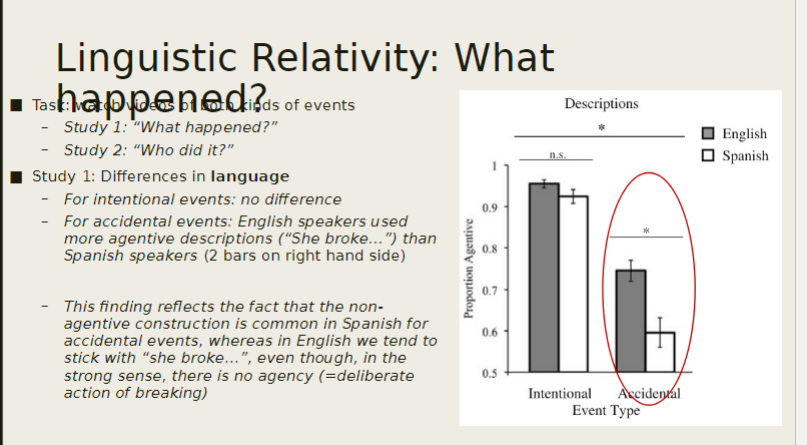Language and thought
1/11
There's no tags or description
Looks like no tags are added yet.
Name | Mastery | Learn | Test | Matching | Spaced |
|---|
No study sessions yet.
12 Terms
what is the traditional view of language?
thought has priority over language and that language is tailored to express the thoughts we have
evidence that the traditional view is correct
some argue that there is a language of thought (‘mentalese’)
it has a lot in common with natural languages
and natural languages are the way they are so that we can externally express what we are thinking in mentalese
what is the linguistic relativity hypothesis (Sapir-Whorf hypothesis)?
language determines thought
evidence for the Sapir-Whorf hypothesis
the Hopi don’t have a ‘linear’ concept of time
the Inuit have vastly more word types for types of snow than English speakers
not having a word for a concept makes it hard/impossible to understand
what are the versions of the Sapir-Whorf hypothesis?
strong (the language someone speaks determines how they think)
weak (the language someone speaks makes certain types of thought easier or harder)
very weak (the language someone speaks affects how easily info can be encoded and remembered)
what are the general criticisms against Whorf?
used a simplistic approach to translation
assumed that every aspect of language and language structure is reflected in thought
ignored the fact that language can express concepts that they do not have single words for
ignores the fact that language differences usually go together with cultural differences which may be more important than language differences in causing different ways of thinking
psychological arguments against Whorf
the classic finding against him: speakers of languages with very different colour vocabularies see colours in similar ways
led to “Basic Colour Terms” by Berlin and Kay (1960) which was seen as cementing an anti-Whorfian position
key characteristics of basic colour terms
terms whose primary meaning is just a colour
different languages have different numbers of these terms
the order in which terms appear in languages is fixed
findings of Robertson et al.’s (2000) colour study
compared Berinmo tribe of New Guinea (only 5 basic colour terms) and English speakers
found that across tasks categorical perception of colour was aligned with colour terms
suggests that perception/thought is guided by language categories
describe Fausey and Boroditsky’s (2010) linguistic relativity
intentional (agentive) vs accidental (non-agentive)

what did Vygotsky say about language and thought?
children’s development of language and thought are initially separate (with early language being mainly vocal imitation) but that ‘internal speech’ gradually becomes the major form of thinking
what are Vygotsky’s three stages of language development?
stage 1 - language and thought are independent
stage 2 - speech is connected to behaviour via overt spoken accompaniments (words direct attention but their connection with action may not be clear to an observer)
stage 3 - after the age of 7 speech becomes internalised and becomes the main way of thinking (the distinction between form and meaning and the mappings between them are mastered)